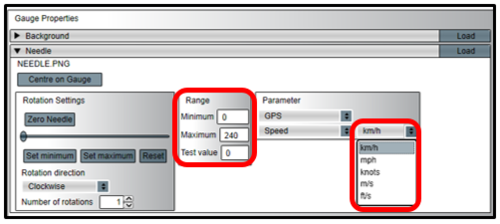04 - VBOX Broadcast Setup Gauges
A gauge can be any shape, but is typically circular with a rotating needle.
Gauges can be used to display any of the available GPS or CAN/input module parameters such as speed (GPS), RPM (CAN/module) etc.
Using a supplied gauge
There are a number of preconfigured gauges which have different ranges and styles that can be inserted into the scene by dragging and dropping.
The parameter which is displayed and what units are being used must be configured using the Gauge Properties section (highlighted).
.png?revision=1)
Gauge creation
Creating a new gauge
Select the Elements Tab on the right hand side. Select Gauge, then use the New button.
.png?revision=1)
Choosing a background
The background of the gauge is the face of the element. The image can be a .bmp, .jpg or .png file. It can contain the numbers for the gauge, or it could be blank, with the numbers being added in afterwards. Examples:
.png?revision=1)
Assigning a needle
Once a background has been selected a needle must be loaded. The needle is a simple vertical image of a needle and must not have any spare space or borders around the image.
.png?revision=1)
Positioning the needle
.png?revision=1)
Defining the range of the needle
.png?revision=1)
Assigning a parameter to the gauge
Any logged parameter can be set to display on the gauge.
.png?revision=1)
Changing the units (e.g. from mph to km/h)
Change the units of the parameter using the drop down menu.
Setting the range
Set the maximum and minimum values to match the face of the gauge. Note that this does not have to start at zero.
.png?revision=1)
Speed labels
The most flexible gauge to use is a blank gauge without any numbers. To use this element, just drag and drop this gauge from the Elements tab onto the scene. Then add the speed labels around the gauge using the Label element type.
The speed range does not have to start from zero, it can go from 25 to 125 for example, but make sure that the same Min (25) Max (125) range is set under Background for this element. Note that the needle will always be drawn over the top of any other element.
.png?revision=1)
Moving gauges around
By clicking and dragging a selection box around a number of elements a temporary group can be created, which can then be dragged anywhere on the scene as one item. Multiple items can also be copied and deleted using this method. Just right click over the grouped elements to bring up a menu of functions.
.png?revision=1)
